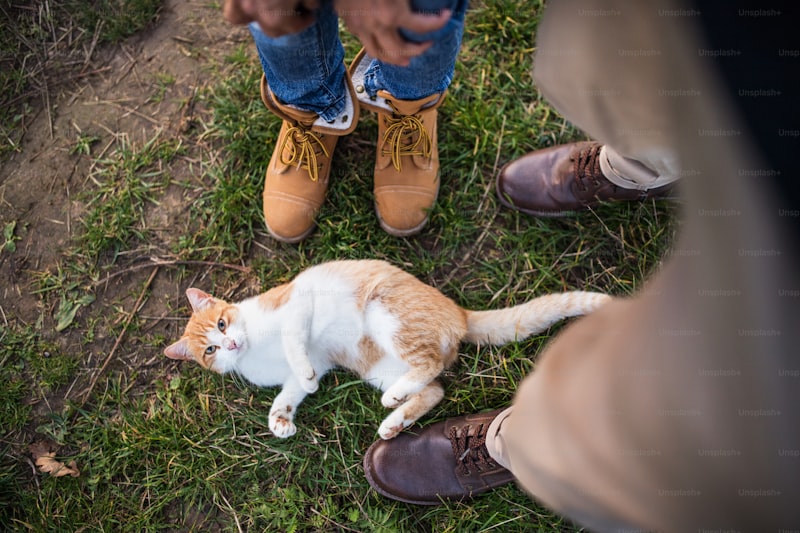When it comes to outdoor cats, ensuring their safety and health becomes a top priority. These independent felines love to roam and explore, but it’s essential to create a safe environment that minimizes risks and keeps them healthy.
Firstly, providing proper shelter is crucial. Whether it’s a cozy cat house or a sheltered area with bedding, outdoor cats need a place where they can retreat from the elements, especially during inclement weather. This not only keeps them comfortable but also protects them from harsh conditions.
Secondly, regular vet check-ups are a must. Outdoor cats are exposed to more potential health risks such as parasites or injuries from fights or accidents. Keeping up with vaccinations and deworming schedules helps prevent diseases and ensures their overall well-being.
Another vital aspect is providing nutritious food and clean water. Outdoor cats have more active lifestyles and need adequate nutrition to sustain their energy levels. Always ensure that food and water bowls are clean and placed in a secure spot away from potential contaminants.
To further enhance their safety, consider using collars with identification tags and microchipping. These precautions increase the chances of a lost cat being reunited with its owner if they wander off or get lost.

Additionally, creating a safe outdoor environment involves removing toxic plants, chemicals, and other hazards from their roaming areas. Cats are curious by nature, and ensuring they don’t come into contact with harmful substances helps prevent accidental poisonings.
Lastly, engaging with outdoor cats through play and affection strengthens the bond between you and your pet. Spending quality time together not only enriches their lives but also allows you to monitor their behavior and health closely.
Urban Jungle: Navigating City Life Safely with Outdoor Cats
Living in a bustling city with your feline companion can be both exciting and challenging. Urban environments, often referred to as concrete jungles, present unique opportunities and risks for outdoor cats. Navigating city life safely with your cat requires careful consideration and proactive measures to ensure their well-being.
Cities offer a plethora of sights and sounds that can captivate curious cats, from bustling streets to hidden alleyways. However, these environments also pose potential dangers such as traffic, stray animals, and toxic substances. To keep your outdoor cat safe, it’s essential to take preventive steps.
Firstly, ensure your cat is properly identified with a collar that includes your contact information. Microchipping is another valuable tool that can reunite you with your furry friend if they wander too far from home. Regular vet check-ups and vaccinations are crucial to protect against city-specific diseases and parasites.
Creating a cat-friendly outdoor space within your urban dwelling can also enrich your pet’s life while keeping them safe. Consider setting up a secure balcony enclosure or a designated area in your apartment where your cat can experience the outdoors without exposure to city hazards.
When allowing your cat outside, supervise their outings to minimize risks. Urban areas often have unpredictable traffic patterns, so teaching your cat to avoid busy streets and intersections is vital. Training them to respond to recall commands can prevent them from wandering into unsafe areas.
It’s also essential to provide mental and physical stimulation for your urban outdoor cat. Interactive toys, scratching posts, and climbing structures can mimic the natural environments cats love while keeping them engaged and active.
While city life can be stimulating for outdoor cats, it requires diligent attention to their safety and well-being. By implementing these tips and staying vigilant, you can create a harmonious balance between urban exploration and feline safety for your beloved pet.
Feline Freedom: Essential Tips for Healthy Outdoor Adventures
Ever wondered how to ensure your feline friend enjoys the great outdoors safely? Feline freedom is essential for a cat’s happiness, but it comes with responsibilities. Here are some valuable tips to make sure your cat stays healthy during their outdoor adventures.
Firstly, consider your cat’s safety by providing a well-fitted collar with an ID tag. This simple step ensures they can be identified if they stray too far. Choose a breakaway collar designed to release if it gets caught, preventing accidents.
Next, create a safe outdoor space for your cat. If you have a yard, install a cat-proof fence or provide a secure enclosure. This allows your cat to experience the outdoors while staying protected from potential dangers like traffic or aggressive animals.
Regular veterinary check-ups are crucial. Outdoor cats are more exposed to parasites and diseases. Ensure your cat is up-to-date on vaccinations and flea/tick preventatives recommended by your vet. This keeps them healthy and minimizes the risk of infections.
Toys and mental stimulation are important for outdoor cats. Interactive toys, climbing structures, and puzzle feeders keep them engaged and mentally sharp. This prevents boredom and reduces the likelihood of destructive behavior.
Feeding your outdoor cat requires careful consideration. Provide a balanced diet appropriate for their age and health needs. Outdoor cats may need more calories to support their active lifestyle, so consult your vet for guidance on feeding schedules and portion sizes.
Lastly, observe your cat’s behavior closely. Cats communicate through body language, so pay attention to signs of discomfort or anxiety. If your cat seems stressed or unwell after outdoor adventures, adjust their outdoor time or environment accordingly.
By following these essential tips, you can ensure your outdoor-loving feline companion stays healthy and happy. Remember, feline freedom is about balancing adventure with safety and well-being.
Guardians of the Alley: How to Protect Outdoor Cats from Predators
Predators like coyotes, owls, and even roaming dogs pose significant threats to outdoor cats. These animals see cats as potential prey, especially during dawn and dusk when hunting instincts peak. To protect our feline friends, proactive measures must be taken.
Firstly, creating a safe outdoor environment is paramount. Consider installing a sturdy cat enclosure or “catio” that allows cats to enjoy the outdoors while remaining protected from predators. These enclosures provide ample space for exploration without exposing cats to direct threats.
Another effective strategy is to ensure that feeding stations are positioned strategically. Placing feeding areas closer to human activity zones can deter predators who prefer to avoid human presence. Additionally, scheduling regular feeding times reduces the likelihood of cats being outdoors during peak predator hours.
Moreover, grooming your cat regularly not only strengthens your bond but also keeps them healthier and more alert. A well-groomed cat is more agile and can react swiftly to potential threats, increasing their chances of evading predators.
Furthermore, using motion-activated lights or sprinkler systems in alleyways and garden areas can startle predators, discouraging them from entering your property. These simple yet effective deterrents can significantly reduce the risk to outdoor cats.
Ultimately, being vigilant and aware of your surroundings is key to protecting outdoor cats. By implementing these practical tips, we can ensure that our beloved alley guardians live long, happy lives while exploring the great outdoors safely.
Weathering the Elements: Ensuring Outdoor Cats Stay Safe in Every Season
Summer poses unique risks for outdoor cats. The blazing sun can lead to dehydration and heatstroke. Providing shaded areas in your yard or garden can offer respite. Consider setting up a cozy shelter where your cat can cool down and relax away from direct sunlight. Ensure fresh water is readily available at all times to keep them hydrated.
Spring and fall bring moderate temperatures but also unexpected showers. Cats may seek shelter under cars or in other hiding spots during rain, putting them at risk of being injured or trapped. Creating a designated, weatherproof shelter with a roof can keep them dry and safe. This shelter should be elevated, with a cozy bed inside to keep them warm and comfortable during cooler evenings.
Winter presents perhaps the greatest challenge. Cold temperatures can be dangerous, leading to hypothermia and frostbite. Insulating their shelter with blankets or straw provides warmth. Additionally, regularly checking for ice formation in their water bowl ensures they have access to liquid water. Cats often curl up in warm places like car engines, so it’s crucial to check before starting your vehicle.
Monitoring their health throughout the year is essential. Regular veterinary check-ups can catch any developing issues early. Flea and tick prevention should also be maintained year-round to safeguard against parasites that thrive in different weather conditions.
Ultimately, outdoor cats can thrive with proper care and preparation. By anticipating the challenges each season brings, you can ensure they enjoy a safe and fulfilling outdoor experience year-round.
Feeding Frenzy: Nutritional Musts for Cats Roaming Outdoors
Protein Power: Outdoors, cats are natural hunters, so protein is crucial. Their diet should be rich in high-quality animal protein to support their active lifestyle and muscle maintenance. Look for cat food that lists meat, poultry, or fish as the first ingredients.
Essential Fats: Fat provides a concentrated source of energy for outdoor cats. Omega-3 and Omega-6 fatty acids are essential for maintaining healthy skin, a shiny coat, and overall immune function. These can be found in fish oils and certain plant oils added to their food.
Hydration Heroes: Water is vital for all cats, but especially for those exploring the outdoors. Encourage your cat to drink plenty of fresh water to prevent dehydration, especially in warmer weather. Wet cat food can also contribute to their overall water intake.

Vitamins and Minerals: A balanced diet for outdoor cats should include vitamins and minerals like taurine, calcium, phosphorus, and vitamins A, D, E, and B complex. These nutrients support everything from vision and bone health to immune function and overall vitality.
Fiber and Greens: Outdoor cats often nibble on grass and other greens, which can help with digestion and provide additional nutrients. Some commercial cat foods also include fiber sources like beet pulp or chicory root to support gastrointestinal health.
Variety and Balance: Just like humans, cats benefit from a varied diet. Rotate different flavors and textures of cat food to keep mealtime exciting and ensure they receive a spectrum of nutrients.
By tailoring your outdoor cat’s diet to meet their specific nutritional needs, you can ensure they have the energy and health to explore their surroundings with vigor. Ready to fuel your feline’s adventures? Keep these nutritional tips in mind and watch your outdoor cat thrive!
From Stray to Safe: Building Trust and Health in Outdoor Felines
Ever wondered about the journey of stray cats from the streets to becoming healthy, trusted outdoor companions? Let’s dive into the transformative process of building trust and ensuring good health for these outdoor felines.
Stray cats often face a tough existence on the streets, navigating through various challenges to survive. But with patience and care, these resilient creatures can be transformed into loving and healthy outdoor companions. Building trust is the first step in this journey.
Imagine encountering a wary stray cat cautiously eyeing your approach. How do you begin to build a bond with such a cautious creature? It starts with respect for their space and needs. Offering food consistently at the same time and place establishes reliability and begins to associate your presence with something positive – a meal.
As trust develops, you can gradually introduce gentle interactions, letting the cat approach you on their terms. This phase requires patience; not all cats will warm up quickly. Some may need weeks or even months to feel secure around humans again.
Health plays a crucial role in this transformation. Stray cats often suffer from malnutrition, parasites, and injuries from their outdoor life. Providing regular meals supplemented with nutritious food aids their recovery. Veterinary care is essential to address any medical issues and ensure vaccinations are up to date.
Outdoor felines also benefit from a safe shelter, protecting them from harsh weather and potential predators. A cozy spot with bedding in a quiet area encourages them to stay close and feel secure.
Metaphorically, earning a stray cat’s trust is like slowly unraveling a puzzle – each piece representing a small breakthrough towards a stronger bond. It’s a journey of patience and understanding, where every milestone, no matter how small, brings immense joy.
Ultimately, transforming a stray cat into a cherished outdoor companion is a rewarding experience that deepens our connection with these resilient animals. It’s about giving them a second chance at a safe and happy life, filled with trust, care, and companionship.
Frequently Asked Questions
How do I protect outdoor cats from common diseases
Learn how to safeguard outdoor cats from prevalent diseases with these essential tips. Discover effective strategies to minimize health risks and promote their well-being.
How can I provide shelter for outdoor cats
Learn effective methods to provide shelter for outdoor cats, ensuring their comfort and safety in various weather conditions. Explore DIY options using affordable materials or consider purchasing ready-made shelters designed specifically for cats. Implementing these shelters helps protect cats from harsh elements and promotes their well-being.
What should I feed outdoor cats for optimal health
Learn what to feed outdoor cats for their best health. Get practical tips on balanced diets that support their outdoor lifestyle, ensuring they thrive.
What are the essential safety precautions for outdoor cats
Discover essential safety precautions for outdoor cats, ensuring their well-being and security. Learn key tips to protect them from hazards such as traffic, predators, and toxic plants. Implement strategies like microchipping and providing a safe outdoor enclosure to keep your feline companion safe and healthy.
What are the best practices for socializing outdoor cats
Discover effective strategies for socializing outdoor cats with expert guidance on gradual exposure to human interaction, providing secure and comfortable spaces, using positive reinforcement techniques, and respecting the cat’s individual pace and preferences.



